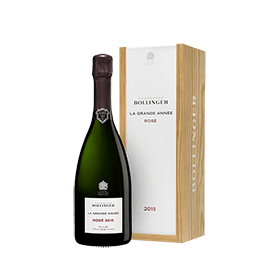For nearly two centuries, Maison Bollinger has been a symbol of Champagne excellence. Founded in 1829 in Aÿ, at the heart of Champagne, this family-owned estate is among the few great houses that remain independent today.
How is rosé Champagne made?
Rosé Champagne can be produced using two main methods. The first, known as blending, consists in adding a small proportion of Champagne red wine to the white wine just before the second fermentation in bottle. The second, called saignée, relies on a short maceration of black grapes, allowing the must to absorb color and aromas from the skins. In both cases, production continues according to the traditional Champagne method, ensuring finesse and complexity.
Bollinger Rosé: exceptional cuvées
Brut Rosé, the art of blending
Created in 2008, this rosé Champagne reflects Bollinger’s exacting standards: combining freshness, structure, and elegance. Composed of 85% Grands and Premiers Crus from three parcels in Verzenay, it showcases the House’s know-how and rigor. Its golden hue, fruity and spicy nose, and fresh, creamy palate make it ideal for an aperitif or a fruit dessert, served at 10–12°C.
La Grande Année Rosé: subtlety, freshness, and finesse
A vintage cuvée, La Grande Année Rosé brings together exceptional crus (Aÿ, Verzenay for Pinot Noir, Chouilly or Le Mesnil-sur-Oger for Chardonnay), complemented by a percentage of red wine from La Côte aux Enfants. Vinified in barrels and aged for a long time, it expresses the delicacy and complexity of these terroirs. Its delicate color precedes a complex nose with fruity notes, blond tobacco, and dried flowers. On the palate, structure, freshness, and gourmandise stretch into a lively, fruity finish. This cuvée pairs with fish, shellfish, fine meats, or fruit-based desserts.



